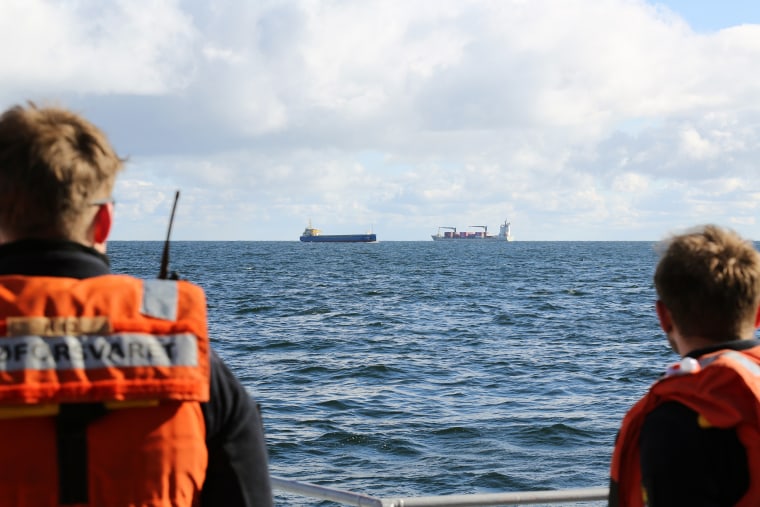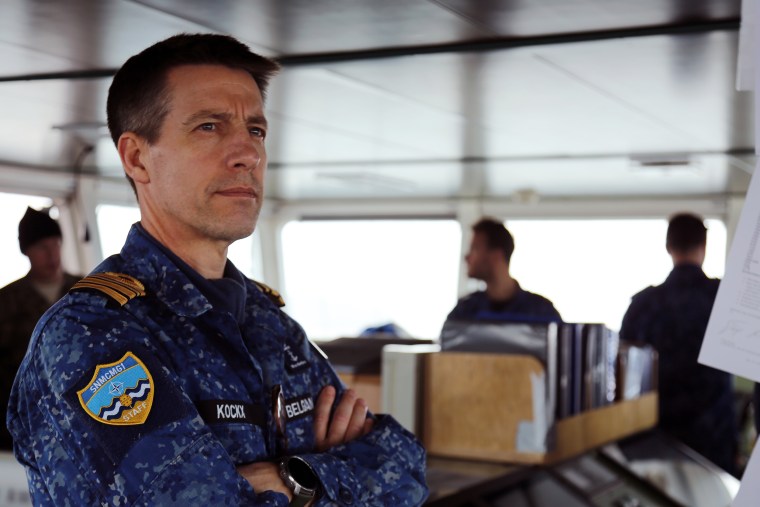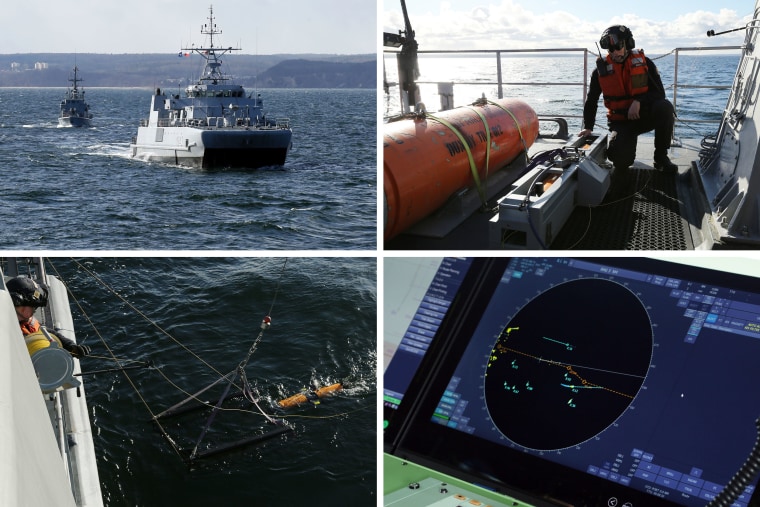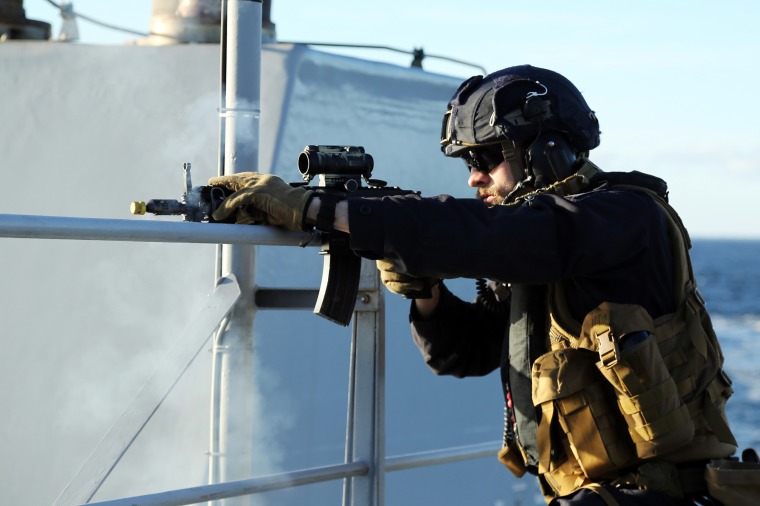ON THE BALTIC SEA — The crew of the Norwegian minehunter gave the black speedboat skimming the waves toward them one last chance to turn back before opening fire with machine guns mounted on the deck.
From the bridge of the HNoMS Hinnøy, officers had tried sounding an air horn and shouting warnings over a loudspeaker. But when the boat kept coming, they were left with little option but to shoot.
This was just an exercise, intended to keep the crew of the Hinnøy sharp as they focused on their real mission: confronting a quiet and stealthy form of Russian aggression.
Even as Presidents Donald Trump and Vladimir Putin negotiate the fate of the war in Ukraine — and express hope for better relations between Washington and Moscow — America’s NATO allies say there has been no letup in Russian sabotage operations across Europe.
One of the Kremlin’s newest threats, according to NATO, is targeting undersea cables carrying vast quantities of data and power beneath the Baltic Sea to countries in northern Europe.
Defending the cables — some of which are no thicker than garden hoses — is the task of a NATO naval patrol known as Baltic Sentry, which started in January. NBC News joined the flotilla of seven ships last week as it sailed the icy sea off Poland, playing cat-and-mouse with suspected Russian saboteurs.
It’s a game in which the rules are murky and the geopolitical stakes are high.

“We are the safety cameras of the Baltic Sea region, and anything that is undertaken unlawfully against critical underwater infrastructure will be seen,” said Cmdr. Erik Kockx, a Belgian naval officer leading the task force.
As he spoke, crew members of the Dutch ship HNLMS Luymes were scanning the horizon with binoculars while computer screens displayed sonar imagery of the cables hundreds of feet below alongside wrecks from World War II.
NATO has accused Russia of waging “hybrid warfare” on both land and sea — covert acts of sabotage big enough to damage European economies but small enough to avoid triggering a Western military response. “It is really state-sponsored sabotage, and in some cases even state-sponsored terrorism,” Mark Rutte, NATO’s secretary general, said at a summit last month.

In the Baltic, analysts say, the threat is not from clearly flagged Russian military vessels but from the “shadow fleet,” merchant vessels that are secretly acting on orders of the Kremlin.
One suspected member of the shadow fleet, according to Finland’s government, is the Eagle S, an aging oil tanker that set sail near St. Petersburg on Christmas Day on a lumbering course through the Baltic.
By 1 p.m. (7 a.m. ET) the ship had crossed over the Estlink-2 power cable connecting Finland to Estonia, according to tracking data provided by MarineTraffic, a maritime analytics firm.
Shortly afterward, authorities detected damage to the Estlink, along with three other cables on the Eagle S’s route.
When Finnish commandos boarded the tanker from a helicopter, they discovered an immediate cause for suspicion: The ship’s anchor was missing. Investigators said they believed it broke off as it was dragged along the seabed — slicing through cables as it went.
The Kremlin had denied any involvement in the Eagle S incident or several other recent cases of damage to undersea infrastructure. Finnish prosecutors have barred three members of the ship’s crew from leaving the country as they weigh bringing criminal charges.
“The events in the Baltic Sea are connected to and must be viewed within the same prism of that escalating sabotage campaign by Russia across Europe,” Matthew Mooney, director of the threat research division at the U.S. cybersecurity firm Recorded Future, said in an interview.
Lt. Cmdr. Sjoerd Knoop, captain of the Luymes, said dragging an anchor along the seabed was an obvious sign of suspicion as the crew searched for saboteurs. “It’s not normal behavior,” he said. Other possible warning signs include sudden changes of speed by the ships in the area around the undersea cables.
Since the launch of Baltic Sentry in mid-January, there have been no clear examples of sabotage. It’s not clear what exactly the warships would do if they did come across an attack. NATO has no law enforcement powers and would most likely have to rely on authorities in its member states to carry out arrests and prosecutions once the suspect ship passed through their territorial waters.
“NATO is here in the first place to deconflict and to deter, and we hope with our mere presence anybody who would think about inflicting damage to critical underwater infrastructure will think twice,” Kockx said.

The number of ships involved in Baltic Sentry fluctuates — seven vessels were involved while NBC News was observing the mission — but all are European. U.S. involvement is limited to reconnaissance aircraft and a small force of Marines equipped with drones deployed to an island off Finland.
In that sense it appears to meet Trump’s demand for a NATO alliance in which European states do more to protect themselves and rely less on the United States.
But what works for a relatively small-scale naval patrol may not be replicable for the defense of a continent, where European allies rely heavily on advanced American capabilities like anti-missile systems and midair refueling.
Some Europeans fear that Trump’s warm words for Putin and his criticism of NATO allies are signs that he is preparing to abandon the traditional U.S. role in Europe’s security.
“It is clear that the Americans — or in any case, the Americans in this administration — do not care much about the fate of Europe,” Friedrich Merz, the incoming chancellor of Germany, said in a televised interview hours after his general election victory on Feb. 23.
Pete Hegseth, the U.S. defense secretary, has said that while the Trump administration remains committed to NATO’s core principle of collective defense, it was shifting its focus from Europe to the Pacific.

NATO naval officers interviewed by NBC News insisted that the political tensions between the United States and its European allies were not filtering down to the operational level. “We are still NATO, we are one, and we are working together, absolutely,” Kockx said.
At the stern of the Hinnøy, there were what appeared to be three small, bright orange submarines. Each was, in fact, a different type of underwater drone. They were designed for the ship’s original purpose of finding and disarming naval mines.
But they have also proved helpful in giving the crew members a detailed look at the undersea cables they are tasked with protecting. One crew member laid an appreciative hand on a Pluto Plus 40, an Italian-made drone about 2 yards long equipped with several cameras.
“It’s a very effective way to get eyes down at the sea bottom,” he said.